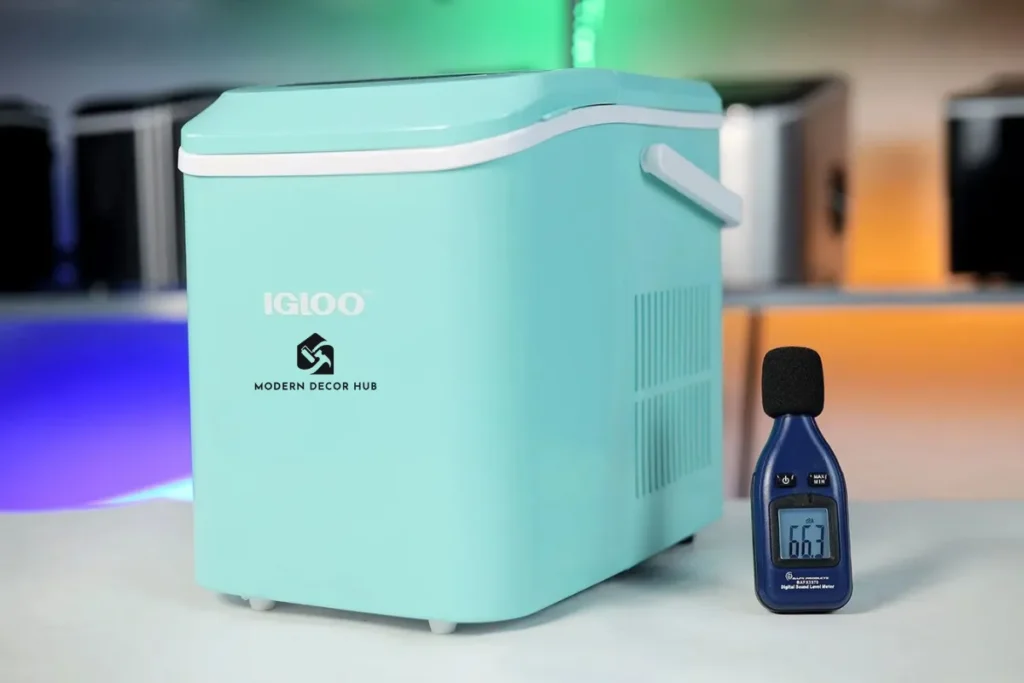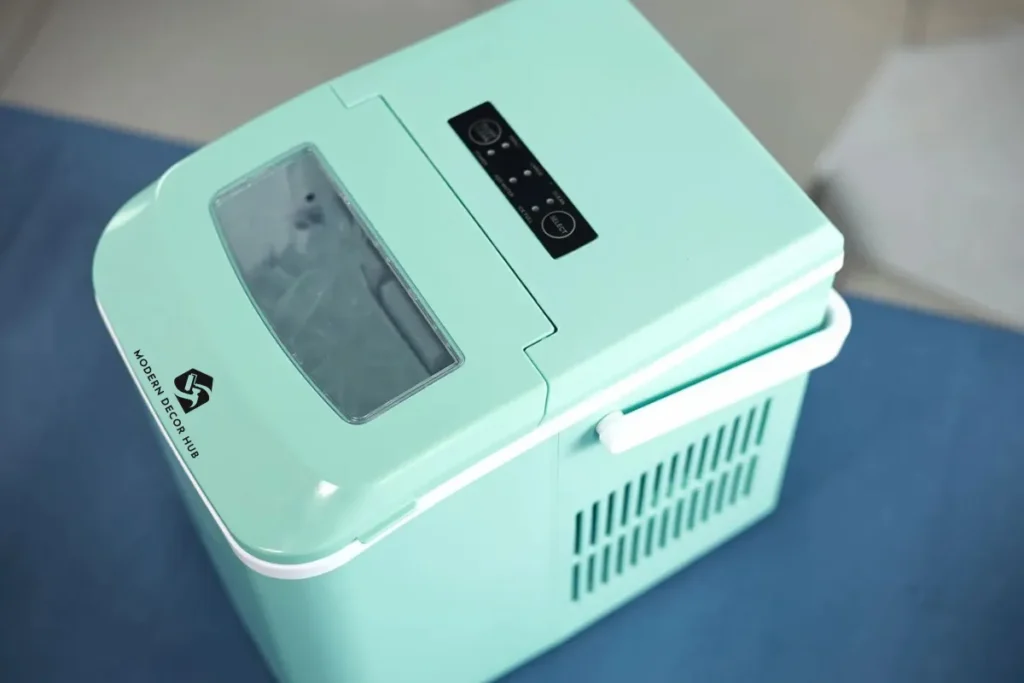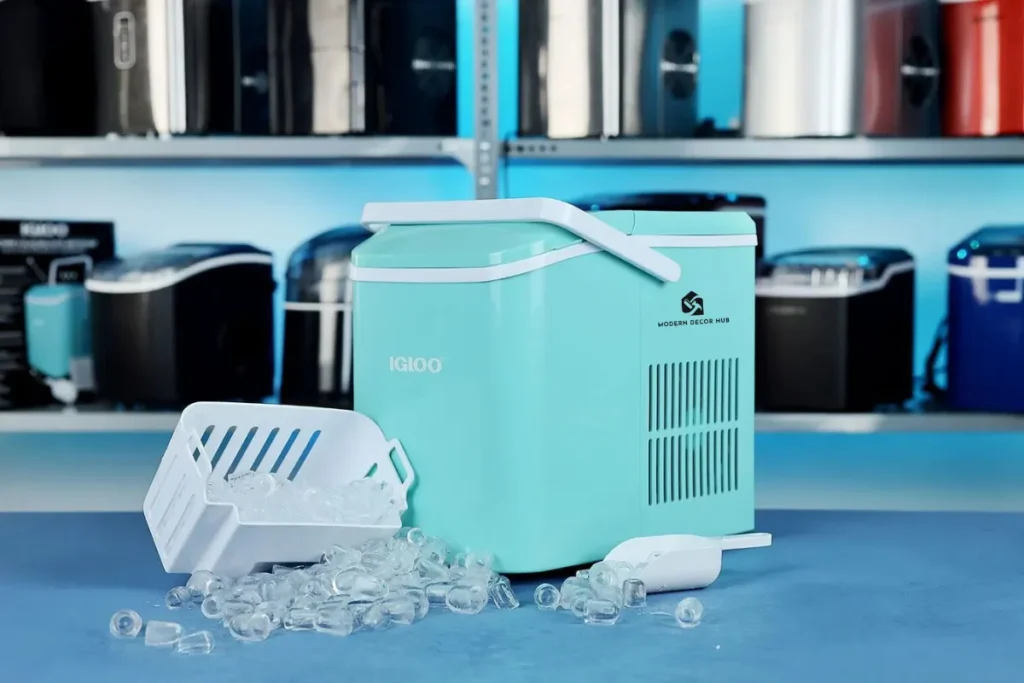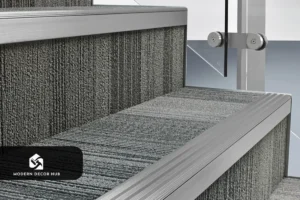Why You Should Care About Your Ice & Your Machine
If you’ve ever pulled out a cube of ice from your Igloo ice machine and noticed it tastes a little off or smells funky, you’re not alone. The truth is, even the coolest Igloo ice machines can build up gunk, slime, or mineral deposits over time. That’s why knowing how to clean Igloo ice machine properly isn’t just a nice-to-have—it’s a must. A clean machine means better-tasting ice, smoother operation, & longer life for your trusty appliance.
Imagine this: you’re hosting friends, the drinks are ready, but when you scoop ice, it smells like… well, let’s just say not refreshing. Gross, right? That’s your cue to roll up your sleeves & give your machine the care it deserves. The good news? Cleaning your Igloo ice machine isn’t complicated or time-consuming. With just a few simple steps & some basic supplies, you can get your ice maker sparkling clean & producing fresh, tasty ice again.
What Happens When You Don’t Clean Your Machine
Here’s why it matters. Over time, water leaves behind tiny minerals, mold can creep into the reservoir, & leftover ice bits can make the interior sticky or slimy. If you ignore it, your ice can pick up odd tastes, your machine might slow down, & worst-case scenario, it could stop making ice altogether. But don’t worry—none of this is permanent, & all of it is fixable. Learning how to clean Igloo ice machine regularly prevents these headaches before they start.
Treat Your Ice Machine Like a Buddy
Think of your Igloo ice machine as a mini kitchen buddy. It works hard to keep your drinks icy, & in return, it needs just a little love. Daily upkeep, weekly deep cleans, & occasional descaling go a long way. And don’t worry—you don’t need fancy chemicals or complicated gadgets. Most of the time, a bit of vinegar, water, & elbow grease is enough to bring your ice machine back to life.
Understanding Your Igloo Ice Machine
Get to Know Your Machine & Its Parts
Before you start to clean Igloo ice machine, it’s helpful to know what you’re dealing with. Think of your ice maker as a small, hardworking team with several important members: the water reservoir, drain plug, ice basket, float switch, & sensors. Each part plays a role in making ice and keeping it fresh. Understanding these parts makes cleaning easier & ensures you don’t miss any hidden corners where gunk or slime can hide.
Common Igloo Models & Their Features
Igloo has several popular models, like ICEB26, ICEB26HNSS, & IGLICEBSC26. Most of these countertop ice makers share similar features:
- Water Reservoir – Holds the water that turns into ice. Always keep it clean to avoid funky smells or off-tasting ice.
- Ice Basket – Where the finished ice cubes land. Residue can build up here if not cleaned regularly.
- Drain Plug – Helps remove leftover water easily. Vital for quick maintenance & deep cleans.
- Sensors & Float Switch – Detect water levels and signal when the machine needs more water. Dirty sensors can cause errors, slow ice production, or “needs water” alerts.
Knowing these parts makes it simple to follow cleaning steps correctly. When you understand how the machine works, you’ll also avoid accidental damage while cleaning.
Why Each Part Matters
Every part of your Igloo ice machine needs attention during cleaning:
- Water Reservoir: If not cleaned, minerals & bacteria can affect taste & ice clarity.
- Ice Basket: Sticky residue or leftover ice can harbor mold.
- Drain Plug: Ensures all water is removed before a deep clean.
- Sensors & Float Switch: Clean sensors mean smooth operation & no annoying error lights.
Even though these parts are small, they’re essential for producing clean, tasty ice. By taking care of them regularly, your machine will run efficiently, & every ice cube will taste fresh & crisp.
Safety First: Preparing to Clean
Why Safety Matters & How to Start
Before you roll up your sleeves to clean Igloo ice machine, safety comes first. Even though your ice maker seems small and simple, it has electrical parts & water inside—mixing those without care can lead to accidents or damage. Taking a few precautionary steps ensures you stay safe & your machine stays happy.
Unplug the Machine & Turn It Off
Step one is simple but crucial: unplug your Igloo ice machine from the power source. Don’t just switch it off—pull the plug. This prevents any electrical mishaps while you’re handling water, draining the reservoir, or scrubbing the interior. Safety first means stress-free cleaning later!
Let the Machine Settle
If you recently moved your ice maker, give it a few minutes to settle. The refrigerant inside can shift during transport. Cleaning or using the machine too soon may affect performance or cause minor issues. Waiting a little ensures everything is stable & ready for cleaning.
Gather Your Cleaning Supplies
Before touching your machine, prepare everything you’ll need:
- Mild cleaning solution (vinegar & water or food-safe detergent)
- Soft cloth or sponge
- Small brush or toothbrush for corners & sensors
- A container or towel for draining water
- Gloves (optional, but helpful)
Having all supplies ready makes the process smooth & prevents unnecessary interruptions. Plus, it keeps your kitchen tidy & avoids spills.
Avoid Harsh Chemicals & Abrasives
Here’s a key tip: never use bleach, strong solvents, or abrasive scrubbers on your Igloo ice machine. These can damage plastic parts, sensors, or seals. Stick to gentle, food-safe cleaners—your ice cubes will thank you with pure taste & no weird odors.
Quick Safety Checklist
Before you start:
- Unplug the machine & turn it off completely.
- Ensure the machine is stable & has settled if recently moved.
- Gather all supplies & plan the cleaning area.
- Avoid harsh chemicals or scrubbing tools that can scratch surfaces.
Following these safety steps ensures that cleaning your Igloo ice machine is simple, safe, & stress-free. Once you’ve completed these preparations, you’re ready to move on to the fun part—getting every part sparkling clean!
How Often to Clean Your Igloo Ice Machine

Daily: Quick Upkeep & Why It Matters
Keeping your Igloo ice machine in top shape doesn’t have to be overwhelming. A little daily care goes a long way. Every day, make sure to replace the water in the reservoir and give the interior a quick wipe. This simple habit prevents mineral buildup, keeps ice tasting fresh, & stops any unwanted smells from developing. Think of it like brushing your teeth—the small daily step keeps bigger problems away!
Weekly: Deeper Clean for Better Ice
Once a week, it’s time for a more thorough cleaning. Remove the ice basket, scoop, & any removable parts, and wash them with a gentle, food-safe solution. Wipe down the water reservoir & other surfaces to remove any hidden residue. Doing this weekly keeps your ice clear, fresh, & free from any slime or gunk that can sneak into hard-to-reach areas. It’s a small commitment that makes a big difference.
Monthly or Periodic Deep Cleaning
Every month—or more often if your machine gets heavy use—it’s smart to give your Igloo ice machine a deep clean. This involves descaling to remove mineral deposits, running self-cleaning cycles if your model has them, & carefully rinsing every part. Deep cleaning prevents buildup that can slow down ice production or create off-tasting ice. It’s like hitting the refresh button for your ice maker.
Signs It’s Time to Clean Immediately
Sometimes your machine will let you know it’s time for cleaning. Keep an eye out for:
- Strange odors coming from the ice
- Cloudy or discolored ice
- Slower ice production than usual
- Error lights or “needs water” signals
If you notice any of these signs, don’t wait—jump in and clean Igloo ice machine right away. Ignoring these signals can affect both the taste of your ice & the longevity of your machine.
Make Cleaning a Routine & Enjoy Better Ice
By establishing a clear routine—daily quick wipe, weekly cleaning, & monthly deep clean—you’re giving your ice maker exactly what it needs to perform at its best. Fresh, clear, tasty ice cubes aren’t just a small joy—they’re a reward for a few minutes of care each day. Stick to this schedule, and your Igloo ice machine will thank you with perfectly chilled drinks every single time!
Step-by-Step Cleaning Guide (Manual Cleaning)
Step 1: Remove Ice & Drain Water
The first step to clean Igloo ice machine is simple: remove any ice in the basket and drain the water from the reservoir using the drain plug. This clears the way for a proper cleaning and prevents old water from mixing with fresh cleaning solutions.
Step 2: Take Out Removable Parts & Inspect
Next, remove the ice basket, scoop, & any other detachable parts. Take a good look at them—this is where gunk, slime, or mineral buildup often hides. Seeing the buildup firsthand makes cleaning more satisfying, and it ensures no part gets overlooked.
Step 3: Prepare a Gentle Cleaning Solution
Mix a food-safe cleaning solution using either vinegar & water or mild detergent with warm water. Some people even use hydrogen peroxide for a deeper clean, but make sure it’s diluted properly. Avoid harsh chemicals or bleach—they can damage your Igloo ice machine and leave unwanted residues.
Step 4: Scrub Every Corner & Cranny
Use a soft cloth, sponge, or a small toothbrush to scrub the interior surfaces, corners, & hard-to-reach areas. Pay special attention to the water reservoir, drain plug area, & any sensors. These spots are magnets for slime or mineral deposits. A little elbow grease here makes a huge difference in ice taste!
Step 5: Rinse Thoroughly
Once all parts and surfaces are scrubbed clean, rinse everything with fresh water. Make sure no cleaning solution remains—residues can affect the taste of your ice. Rinsing well also prevents irritation if you plan to handle the ice directly afterward.
Step 6: Dry Completely Before Reassembly
Before putting everything back together, dry all parts completely. Leaving water behind can encourage mold growth or create lingering odors. A dry Igloo ice machine is a happy ice machine!
Step 7: Reassemble & Run a Test Cycle
After drying, reassemble your ice maker, fill it with fresh water, and run a short cycle to make sure everything works properly. Discard the first batch of ice—it might have traces of cleaning solution or dust from scrubbing. From the next batch onward, enjoy fresh, clean ice every time!
Using the Self-Cleaning Function
Which Models Have a Self-Clean Feature & Why It Helps
Some Igloo ice machines come with a convenient self-cleaning function. This feature makes it even easier to clean Igloo ice machine without disassembling every part. Models like ICEB26HNSS & IGLICEBSC26 often include this cycle, which uses warm water & safe cleaning solutions to flush out residues automatically.
The self-clean function is especially helpful for busy folks or anyone who wants a quick, hands-off way to maintain their ice maker. It ensures internal parts, like the water reservoir & sensors, get cleaned properly—areas that can be tricky to reach manually.
How to Activate the Self-Clean Cycle
Using the self-cleaning function is usually simple:
- Turn off the machine and remove any remaining ice.
- Fill the reservoir with the recommended food-safe cleaning solution or a vinegar & water mix.
- Press the self-clean button (check your model’s manual for exact instructions).
- Let the machine complete the full cycle—it typically takes 15–30 minutes.
What to Do After the Cycle
Once the self-cleaning cycle finishes:
- Discard any water or ice produced during the cycle. It may contain residues from the cleaning solution.
- Rinse the reservoir with fresh water to remove any leftover cleaning solution.
- Wipe down removable parts if needed, to make sure everything is completely clean.
How Often to Use the Self-Clean Function
Even with daily & weekly maintenance, running the self-clean cycle once a month—or more often if your machine sees heavy use—keeps your Igloo ice machine in top condition. It prevents mineral buildup, slime, & odors, so every cube of ice stays fresh, clear, & tasty.
Descaling & Mineral Buildup Removal
Why Descaling Matters & How It Affects Your Ice
Over time, minerals in water—like calcium & lime—can leave deposits inside your Igloo ice machine. This buildup, known as scale, may slow down ice production, affect the taste of your ice, or even cause parts to malfunction. That’s why descaling is a key step in keeping your ice maker running smoothly & producing fresh, clean ice.
Signs Your Machine Needs Descaling
You may need to clean Igloo ice machine for mineral buildup if you notice:
- Ice cubes forming slower than usual
- Cloudy or chalky ice
- A white or crusty residue in the water reservoir or on removable parts
Catching mineral buildup early makes descaling easier and protects your machine from long-term damage.
Safe & Effective Descaling Solutions
For most Igloo ice machines, you can safely use:
- Vinegar & water mixture (1 part vinegar to 10 parts water)
- Citric acid solution (food-grade)
- Occasionally, a mild hydrogen peroxide solution for stubborn spots
Avoid harsh chemicals or strong acids—they can damage plastic parts, seals, & sensors.
Step-by-Step Descaling
- Empty the machine: remove ice & drain water completely.
- Mix your descaling solution: vinegar, citric acid, or hydrogen peroxide diluted as recommended.
- Fill the reservoir and let the solution sit for 10–15 minutes to loosen mineral deposits.
- Scrub gently: use a soft brush or cloth to remove any visible scale.
- Run a cleaning cycle (manual or self-clean) to flush the solution through the system.
- Rinse thoroughly: refill with fresh water and discard the first batch of ice to remove any traces of the solution.
Food-Safe Cleaning & Sanitizing Tips
Why Food-Safe Cleaning Matters & How It Helps
When you clean Igloo ice machine, it’s not just about removing slime or dirt—it’s also about keeping your ice safe to eat & drink. Using harsh chemicals or strong bleach can leave residues that affect taste or even pose health risks. Food-safe cleaning ensures every cube of ice is fresh, clear, & perfectly safe for your favorite drinks.
Recommended Food-Safe Cleaning Solutions
You don’t need fancy products to sanitize your Igloo ice machine. Some of the best options include:
- Vinegar & water mixture – gentle & effective against bacteria & odors
- Hydrogen peroxide (diluted) – removes stubborn odors without harming the machine
- Mild dish soap – safe for wiping removable parts & surfaces
- Citric acid (food-grade) – great for removing mineral buildup while keeping it safe
These solutions clean thoroughly without leaving chemical residues that can alter the taste of your ice.
Steps to Sanitize Safely
- Remove ice & drain water completely.
- Wash removable parts (basket, scoop, filter if any) with a food-safe solution.
- Wipe down the interior with a soft cloth dipped in your chosen cleaner.
- Rinse thoroughly with fresh water to remove any leftover cleaning solution.
- Dry all parts completely before reassembly to prevent mold or mildew.
Extra Tips for Food-Safe Maintenance
- Avoid bleach or harsh chemical cleaners—they can damage plastic & sensors.
- Always discard the first batch of ice after cleaning—it may contain traces of cleaning solution or dust from scrubbing.
- Consider running a self-clean cycle with vinegar or a recommended food-safe solution if your model has the option.
Troubleshooting Common Issues

Ice Machine Won’t Produce Ice & What to Do
Even after you clean Igloo ice machine, sometimes it might not make ice. Don’t panic—this is usually an easy fix. First, check the water reservoir to make sure it’s full. Next, inspect the float switch & sensors; mineral buildup or debris can sometimes block them. Running a quick rinse or self-clean cycle often solves this issue.
Red Light or “Needs Water” Alerts
If your ice maker shows a red light or a “needs water” alert even when the reservoir is full, it could be a sensor problem. Dirt, slime, or mineral buildup can interfere with sensor readings. Cleaning the reservoir, float switch, & surrounding areas usually fixes the problem, letting your Igloo ice machine resume normal ice production.
Cloudy Ice & Strange Taste
Cloudy or off-tasting ice can result from leftover water, mineral deposits, or leftover cleaning solution. To fix this:
- Run a fresh water rinse cycle.
- Discard the first batch of ice after cleaning.
- Use filtered water for better clarity & taste.
Following these steps regularly keeps your ice clear, tasty, & safe to enjoy.
Mold, Slime, & Odor Issues
Mold or slime inside the machine can happen if cleaning is skipped for a while. Signs include funky smells or a slimy texture inside the reservoir. A thorough manual cleaning, combined with a food-safe sanitizer or vinegar solution, usually removes these problems. Make sure to dry all parts completely afterward to prevent regrowth.
Preventing Future Issues
- Stick to your daily, weekly, & monthly cleaning schedule.
- Always use food-safe cleaning solutions.
- Run the self-clean cycle periodically if your model has it.
- Check sensors, float switches, & the water reservoir during every deep clean.
By following these troubleshooting tips, your Igloo ice machine will continue making fresh, clean ice without interruption. A little care goes a long way toward avoiding bigger problems down the road.
Maintaining Ice Quality
Why Ice Quality Matters & How Cleaning Helps
Your ice isn’t just frozen water—it’s a small but important part of your drinks. If your Igloo ice machine isn’t properly maintained, ice can taste off, look cloudy, or even carry odors. Regular cleaning ensures every cube is fresh, crisp, & perfect for your favorite beverages. Think of it as giving your drinks a little extra love with every sip.
Use Filtered Water & Keep Reservoir Fresh
One of the easiest ways to maintain ice quality is to use filtered water. Tap water can contain minerals that leave deposits inside the machine, affecting both taste & clarity. Fresh water also prevents lingering odors and ensures your ice is pure from the start. Replacing the water daily is a simple habit that makes a huge difference.
Proper Storage & Lid Management
Keeping your Igloo ice machine closed when not in use prevents dust, kitchen odors, or contaminants from reaching the ice. Make sure the lid seals properly, and avoid opening it frequently without reason. This small step preserves ice quality and keeps every cube tasting great.
Monitor for Cloudy Ice & Take Action Quickly
Cloudy ice can be a sign of mineral buildup, old water, or leftover cleaning solution. If you notice ice cubes turning cloudy, it’s time to run a rinse or deep clean cycle. Discard the first batch after cleaning—this resets the taste and ensures subsequent ice is fresh & clear.
Regular Maintenance Equals Perfect Ice
Combining routine cleaning, proper water management, and mindful storage guarantees that your Igloo ice machine consistently produces high-quality ice. When you follow these steps, you’ll enjoy ice that’s not only clean & safe but also looks crystal clear & tastes amazing every time.
Final Thoughts
Keeping your Igloo ice machine clean ensures fresh, clear, & tasty ice every time. With simple daily, weekly, & monthly care using food-safe solutions, your machine stays efficient, odor-free, & long-lasting. A little cleaning goes a long way—enjoy perfect ice with minimal effort!
FAQs
How Often Should I Clean My Igloo Ice Machine & Why?
To keep ice tasting fresh & your machine running smoothly, follow a simple schedule:
- Daily: replace water & quick wipe
- Weekly: clean removable parts & wipe the interior
- Monthly: deep clean & descale if needed
Regular cleaning prevents slime, mold, & mineral buildup, ensuring every ice cube is clear, crisp, & safe.
Can I Use Bleach or Harsh Chemicals?
No! Avoid bleach or strong chemicals—they can damage your Igloo ice machine & leave residues that affect ice taste. Stick to food-safe cleaning solutions like vinegar, citric acid, or mild dish soap for safe & effective cleaning.
My Machine Doesn’t Have a Self-Clean Cycle—What Should I Do?
No worries! Manual cleaning works just as well. Remove ice, drain water, wash removable parts, scrub interior surfaces, rinse thoroughly, & dry completely. Following these steps regularly keeps your Igloo ice machine in perfect working order.
How Do I Remove Stubborn Odors or Slime?
If you notice odors or slime, try a vinegar & water rinse or dilute hydrogen peroxide. Scrub corners & nooks with a soft brush, rinse well, & dry completely. Running a short self-clean cycle afterward helps flush out any leftover residues.
Why Is My Ice Cloudy Even After Cleaning?
Cloudy ice can be caused by mineral deposits, old water, or trapped air. Use filtered water, clean the reservoir thoroughly, & discard the first batch after cleaning. Following these steps ensures your Igloo ice machine consistently produces crystal-clear ice.




